World War II was a time of intense emotions: excitement, fear, homesickness, longing, love. Young men, away from home for the first time and facing an uncertain future, sought comfort in correspondence to sweethearts waiting back home or in the arms of young women they met abroad. Whirlwind romances led to wartime weddings in rapid succession, many of which did not lead to "happily ever after." Young couples on the home front scheduled weddings around service leaves and passes, a choice that required ingenuity and flexibility.
Couples in the military had their own obstacles to romance to overcome. Enlisted women were permitted to date enlisted men, but relationships with male officers were restricted to servicewomen of higher rank. Other restrictions were imposed by the military on servicemen and women who chose to marry while on active duty. The Army would not permit married couples to serve in the same theater of operations, and split them up accordingly. The Navy and Marines allowed women to marry after completion of basic training, but would not allow a woman to marry a man in her own branch of service, a restriction that was later relaxed.
Young wives with husbands away at war struggled to maintain some semblance of normal home life for their children, while holding down jobs to supplement meager military allotments. As the war dragged on, some soldiers and sailors received "Dear John" letters from wives and girlfriends who had grown tired of waiting and had met someone new.
For better or for worse, wartime romance set the stage for both the dramatic "baby boom" that followed, and for the unprecedented rates of divorce post-war, as American servicemen returned home and readjusted to civilian life.
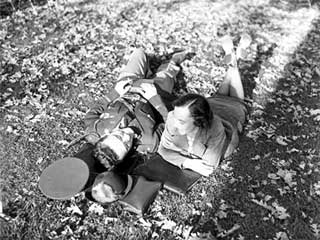
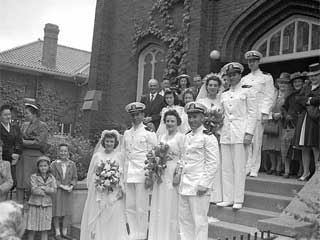
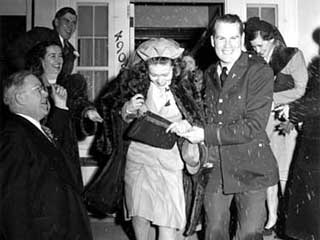
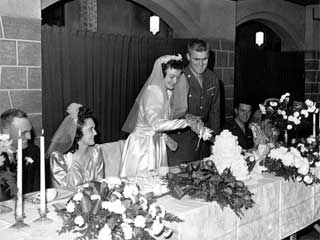
"I do!"
Getting married during World War II presented a unique set of challenges to young bridal couples. With grooms marching off to war or home on brief leaves from the service, wedding plans were made quickly and "I do's" were said in churches, homes, civil offices, and even funeral chapels.
Robert Williams McKewin and his bride, Patricia Berry, managed to have a church wedding while he was home on a 3-day pass. Doris Shea and her fiancé, Errol Fox, changed their plans for a wedding in Minnesota when his leave was canceled, and they found themselves getting married in a chapel at Forest Lawn Cemetery near Los Angeles.
Planning a wedding around wartime shortages required teamwork and ingenuity. Sugar ration coupons were saved up and taken to the bakery to be applied to the wedding cake. Brides wore traditional white gowns, but their trousseaus were often utilitarian in nature to save on wool and other materials. Honeymoons, if time allowed, were spent close to home to save on gas and tire wear.
Weddings abroad relied on the military's cooperation, as in the case of Pillager, MN native Pearlie Hargrave, whose marriage to Michael McKeogh meant an army-requisitioned gown, and a ceremony held at Marie Antoinette's Chapel Royal at the Palace of Versailles with General Eisenhower in attendance.
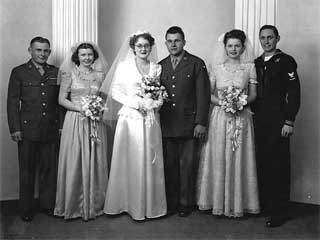
My Girl Back Home
The separation caused by wartime service was keenly felt by young couples whose dreams for a future together were suddenly put on hold. Thoughts of a "girl back home" sustained many a soldier during months of training stateside and combat duty in foreign places. As the war progressed, letters and photographs from that someone special on the home front or in the service fanned the flame and soothed sagging spirits and longing hearts.
Promises of "I'll wait for you" made absences easier to bear. For some, the wait was too difficult. A long-distance relationship might end with infidelity on one or both sides, followed by a "Dear John" letter or, worse, no letter at all.
Romance by correspondence was enough for come couples to strengthen and sustain a relationship. Roy Bruchman and Doris Solie wrote frequently, sharing their feelings for one another and making plans for a future together. John and Georgiana Sonnen, married before the war and the parents of a small boy, kept each other close through long, newsy letters filled with expressions of tenderness and longing. For these sweethearts, the wait was well worth it when, at the end of the war, "Johnny came marching home" to the arms of the girl he loved, ready to build a life together.
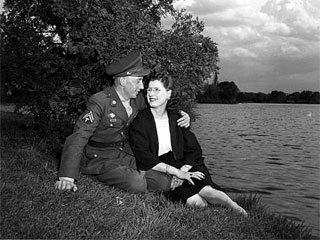
Citations:
- Leder, Jane Mersky, Thanks for the Memories: Love, Sex and World War II. Westport, CT: Praeger Publishing, 2006.
- Steele, Evelyn, Wartime Opportunities for Women. New York: E.P. Dutton & Co., Inc., 1943.
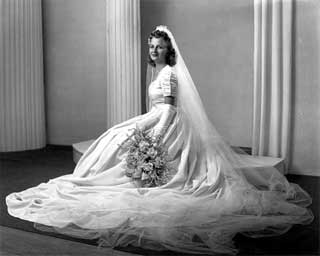 Photo: Wedding in the family of Mr. and Mrs. W. Bloomquist; portrait of bride, 1941.
Photo: Wedding in the family of Mr. and Mrs. W. Bloomquist; portrait of bride, 1941.- McKeogh, Michael J. (Mickey) and Richard Lockridge, Sgt. Mickey and General Ike. New York: G.B. Putnam's Sons; Michael J. McKeogh, Richard Lockridge, 1946.
- McKewin, Robert Williams, Marriage and Graduation on a 3-Day Pass. Minnesota Historical Society: Share Your Story, 2006.
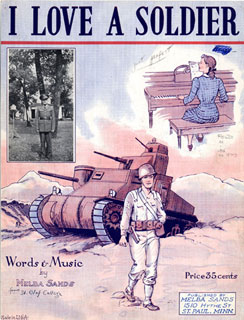 Document: I love a soldier.
Document: I love a soldier.- Strand, Doris Shea; Thomas Saylor, Interviewer, Minnesota's Greatest Generation Oral History Interview, Thomas Saylor; Minnesota Historical Society Oral History Collection, 2002.
- Bruchman, Royal, Doris Solie, Royal and Doris Bruchman letters and memoirs, 1941-1952, 1996. Minnesota Historical Society Manuscripts Collection.
- Sonnen, John S., John and Georgiana Sonnen correspondence, 1944-1946. Minnesota Historical Society Manuscripts Collection.


